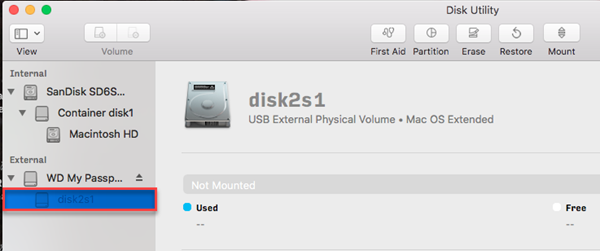Launch Disk Utility. Either head to Applications Utilities, or tap Command + Space and start typing.
Most external hard drives are designed to work for Windows computers. So if you’re trying to connect an external hard drive to a Mac, you might have to format the drive before you can use it. Here’s how to do that:
- Make a connection. To format an external storage device, connect it to one of the ports on your.
- Causes: The disk drive in the system is formatted with a file system other than Mac OS Extended (Journaled) or it is formatted as Case-sensitive. AutoCAD installation on Case-sensitive volumes is not supported. Starting with Mac OS 10.5, the default file system is HFS+ or Mac OS Extended.This is the only file system on which AutoCAD for Mac 2011 through 2017 will run.
- External drive connected to your Mac. Time Machine can back up to an external drive connected to.
How to Format a Hard Drive for Mac
Note: If you already used your external hard drive on a PC, be sure to back up any files on it. Formatting your drive will wipe out all the data in it.
- Connect an external hard drive to your Mac. Some external hard drives need to be plugged into an outlet to work.
- Go to Spotlight Search, type in Disk Utility, and click the first option. This will open the Disk Utility app, where you will find all the internal and external drives that are connected to your Mac.
- Then click View in the top-left corner of the window and select Show All Devices.
- Click the external hard drive you want to format. You can find this on the left-hand side of the screen under External Hard Drives. For the best result, select the disk (the highest option in the external tree).
- On the top menu, click Erase. This will open a small pop-up window with a warning that erasing the drive will delete all data stored on it and that it can’t be undone.
- Choose a name, format, and scheme for your drive. You can choose whatever name you want, and you should choose GUID Partition Map for the Scheme in most cases. However, you can choose between the following formats:
- Mac OS Extended (Journaled) is the best option for most Mac users since it is compatible with all Macs.
- APFS (Apple File System) is only for newer Macs running macOS 10.13 or later.
- exFAT is compatible with both PC and Mac.
- MS-DOS (FAT) is also compatible with Mac and PC, but you can only transfer files smaller than 4GB.
- When you’re done with providing the setup details, click Erase. This will immediately wipe the entire drive.

If you get an error message that states, “Erase process has failed. Click done tocontinue,” don’t freak out about it. This is an issue caused by Time Machine running on your externaldrive.
You will need to turn off Time Machine. You can do this by opening System Preferences and unchecking the boxnext to “Back Up Automatically”.Then click Options beside “ShowTime Machine in menu bar.” This will open another window. Click Cancel and it will turn off the Time Machine.
After you turn off the Time Machine, redo steps 4 to 6.
How to Partition anExternal Hard Drive on Mac
If you have formattedyour drive, you can then partition the drive, which will splitthe drive into two formats. This is perfect for anyone who uses Macs and PCsand wants to transfer files between the different operating systems with anexternal drive. Here’s how to do that:
- Open Disk Utility and select the drive that you want to partition. It is best to click View > Show All Devices so you can selectthe disk rather than a container.
- In the top menu, select Partition.
- Then click the plus sign at the bottom of the pie chart. Every time you click this plus sign, a new partition will becreated.
- Choose a name, format and size for each partition. You can also change the size of each of the partitions bydragging the white dots at the edge of the circle.
- Finally click Apply.
Why Partition a Hard Drive?
Partitioning an external hard drive allows youto have separate drives for Mac, PC, and any other operating system. Now youdon’t have to go out and buy hard drives for every computer you use.
A partition also gives you a dedicated space foryour Time Machine back-up files or a bootable backup of your operating system.It also helps protect your data if your drive gets infected with malware, as itwould be contained within one of the partitions.
Now that you know how to format an external drive for Mac, check out our blog on the difference between an HDD and an SDD.
Mac Os Extended Journaled Encrypted


Mac Os Extended Journaled Format
Was this article helpful?
Related Articles
